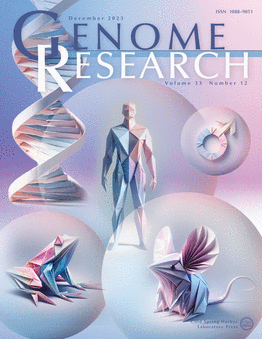极端的异位配和高比率的性别反转重组导致了峨眉胡子蟾蜍大而同态的性染色体
IF 5.5
2区 生物学
Q1 BIOCHEMISTRY & MOLECULAR BIOLOGY
引用次数: 0
摘要
与鸟类和哺乳动物的性染色体高度退化不同,许多两栖动物具有同态性染色体,这可能是由于性染色体的高更替率和/或偶尔在X和Y(或Z和W)染色体之间重组造成的。然而,维持同态性的分子基础仍然难以捉摸,特别是罕见的重组事件阻止性染色体分化的力量。在此,我们鉴定了峨眉胡子蟾蜍的性染色体,并研究了维持同态性的潜在机制。虽然性染色体是同态的,但我们观察到一个广泛的X-Y遗传分化区域,跨越约349 Mb,是迄今为止已知的最大的脊椎动物。尽管如此大的尺寸,并且假设倒置催化了X和Y染色体之间的重组抑制,我们发现很少有证据表明XY结构变异。利用高密度连锁图谱,我们发现X-Y分化的大区域可能是由于在祖先的低雄性重组区域出现了性别决定因素。种群遗传数据显示,性别反转的XY型雌性比例很高,这些个体的X染色体和Y染色体之间的重组有助于维持Y染色体上序列和基因表达的完整性。最后,我们揭示了性染色体内基因表达的适度性化,并确定了参与性腺发育的候选基因。我们的研究结果不仅显示了在祖先低重组条件下大量性别分化区域的显著维持,而且强调了同态染色体的X-Y重组在大基因组区域的维持能力。本文章由计算机程序翻译,如有差异,请以英文原文为准。
Extreme heterochiasmy and high rates of sex-reversed recombination result in large yet homomorphic sex chromosomes in the Emei moustache toad
Unlike the highly degenerated sex chromosomes in birds and mammals, many amphibians possess homomorphic sex chromosomes, which may result from high rates of sex chromosome turnover and/or occasional recombination between the X and Y (or Z and W) Chromosomes. Yet the molecular basis for maintaining homomorphy remains elusive, particularly the power of rare recombination events to arrest sex chromosome divergence. Here, we identified sex chromosomes of the Emei moustache toad and examined potential mechanisms of maintaining homomorphy. Although the sex chromosomes are homomorphic, we observed an extensive region of X-Y genetic differentiation, spanning ~349 Mb, among the largest known to date in vertebrates. Despite this large size, and the assumption that inversions catalyze recombination suppression between the X and Y Chromosomes, we found little evidence of XY structural variation. Using a high-density linkage map, we revealed that the large region of X-Y divergence was likely due to the emergence of sex determining factors in the region of ancestrally low male recombination. Population genetic data showed high rates of sex reversed XY type females, and recombination between the X and Y Chromosomes in these individuals help maintain the integrity of sequence and gene expression on the Y Chromosome. Finally, we revealed modest sexualization of gene expression within the sex chromosomes, and identified candidate genes involved in gonadal development. Our results not only show remarkable maintenance of vast sex differentiated regions under ancestral low recombination, but also emphasize the sustaining power of X-Y recombination for homomorphic chromosomes over large genomic regions.
求助全文
通过发布文献求助,成功后即可免费获取论文全文。
去求助
来源期刊

Genome research
生物-生化与分子生物学
CiteScore
12.40
自引率
1.40%
发文量
140
审稿时长
6 months
期刊介绍:
Launched in 1995, Genome Research is an international, continuously published, peer-reviewed journal that focuses on research that provides novel insights into the genome biology of all organisms, including advances in genomic medicine.
Among the topics considered by the journal are genome structure and function, comparative genomics, molecular evolution, genome-scale quantitative and population genetics, proteomics, epigenomics, and systems biology. The journal also features exciting gene discoveries and reports of cutting-edge computational biology and high-throughput methodologies.
New data in these areas are published as research papers, or methods and resource reports that provide novel information on technologies or tools that will be of interest to a broad readership. Complete data sets are presented electronically on the journal''s web site where appropriate. The journal also provides Reviews, Perspectives, and Insight/Outlook articles, which present commentary on the latest advances published both here and elsewhere, placing such progress in its broader biological context.
 求助内容:
求助内容: 应助结果提醒方式:
应助结果提醒方式:


